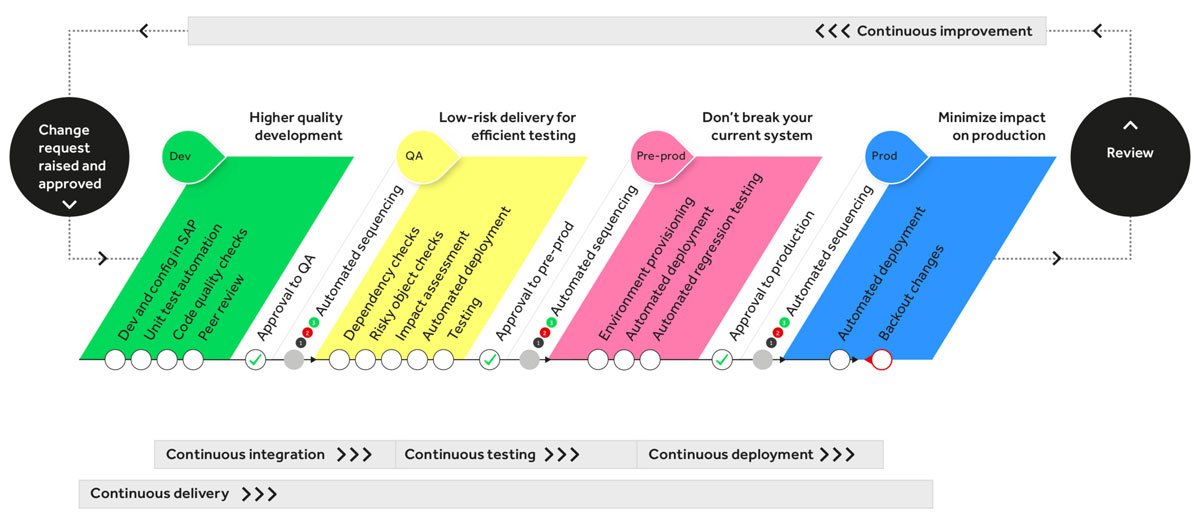
SAP, DevOps and You
Adopting proper DevOps methodologies is hard but it has proven to brings great value to an organization that correctly utilizes it. Considering the multitude of innovation or digital transformation projects that IT teams have to deliver today, the value of proper DevOps cannot be understated. Embracing DevOps cuts down on the time needed for upgrades or implementations and decreases the risks associated with IT projects. As SAP users, there are 4 key areas that you need to have for a successful DevOps adoption and they are:
- Continuous Integration
- Continuous Delivery
- Continuous Testing
- Continuous Deployment
These may seem straightforward but they are critical parts of an Agile Application Lifecycle Management. Having the ability to automate and continuously drive your IT processes also brings about the advantage of shorter developer cycles. This translates into faster deployments of bug fixes, software improvements or even better quality of life changes for the IT team. This provides a competitive advantage for your business or a unique position that you are able to differentiate from your competitors.
The chart above describes the ideal DevOps processes for SAP landscapes or projects. From the chart, you can see that DevOps is not an easy process and it would require multiple teams to work together cohesively and constantly provide feedback. Thankfully, SAP has released tools that would help this process. SAP Focused Solutions was created with agile DevOps processes in mind and tools within Focused Build like the Readiness Solution dashboard greatly helps the team with visual cues. The barrier to adopt SAP DevOps can be further reduced with it is based on effective use of change control automation platforms like SAP Solution Manager.
Once the right tools are in place, SAP recommends a 3 level pathway to DevOps:
- Develop a multi-speed approach to managing SAP change
- Introduce agile development methodologies
- Graduate to a DevOps approach
Develop a multi-speed approach to managing SAP change
There is certainly a difference in speed which IT teams manage different software, even within SAP’s ERP. Certain parts of the software requires more attention than others and this is unavoidable. However, this does not mean that all SAP change needs to be slow, or that governance and control should result in sluggish delivery of system of record changes.
Through a multi-track approach, your IT team can control the speed of change without increasing the risk. By separating the type of change required, or by the potential risk impact, you can segregate each change into its own category with its own delivery and approval track. You can easily do with the change management tools found within SAP Solution Manager.
Divide the work into types of change by potential impact and run each type down its own delivery and approval track. Low impact being the faster tracks with fewer approvals and minimal testing and higher impact the slower tracks.
Introduce agile development methodologies
You might now be familiar with sprints, stories, releases, or other methods of software agile that breaks up development into smaller pieces of work. It is now time to implement the continuous delivery/continuous integration processes from the chart above. Again, tools like SAP Test Suite can greatly aid in the test and development automation to help lower the overall impact and risks involved.
This stage also builds on the multi-track release methodology and you are encouraged to further segregate work categories to streamline your processes. This allows for all tasks to be planned, managed and monitored by PMO team with the easier tasks to be completed quicker and the harder tasks to be done properly.
Graduate to a DevOps approach
At this stage, your team should be extremely familiar with the best practices of Agile and the tools that enable your team to continuously deliver and integrate. As more of your team “shifts left”, you will start to be able to reap the benefits and thereby increase the speed and volume of which changes are carried out.
Eventual Outcomes
As more of these changes are introduced throughout the organization, you will see a momentum of changes that will accelerate the potential and value of your IT team. Bear in mind that a successful adoption of SAP DevOps means that the speed, quality improvements and risk reduction go hand in hand with the ability and flexibility to change their SAP environments. DevOps is a strong accelerator to meet the demands of your business requirements while not compromising business continuity. If you’d like to discuss more about SAP DevOps, we are more than happy to engage!
The Benefits of Using Azure DevOps Connector for SAP Solution Manager Focused Build
Digital transformation is essential in today's business landscape, and SAP S/4HANA has been a game-changer…



